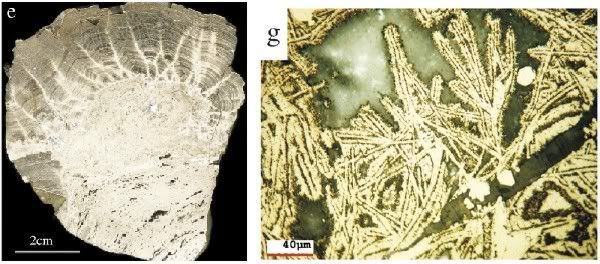These are pretty cool – some excellently preserved black smoker chimneys from a 1.43 billion year-old massive sulphide body in northern China:
Hydrothermal vents occur at mid-ocean ridges or volcanic hotspots: seawater, permeating down through cracks in the crust, comes into contact with hot rocks above the magma chamber, and reacts with them as they are heated to a couple of hundred degrees C - leaching out metals such as lead, copper, zinc and iron. These hot, buoyant fluids then return to the surface at vent sites, mix with sulphate-rich seawater and rapidly cool, leading to the precipitation of iron sulphides in chimney-like structures. Here’s a more typical view:
Individual vents are generally short-lived, and when the upwelling hot fluids inevitably migrate somewhere else, the fragile spires tend to collapse under their own weight. Massive sulphide bodies – valuable sources of metal ore - are built from the debris of many generations of collapsed smokers in a long-lived vent field. So it’s quite rare to see such well-preserved fragments. I just wish the authors had included some pictures of the things in situ.
Under the microscope, you can even see evidence of fossilised microbes: on the outside of the chimneys are stromatolite-like ‘microbialites’ – layered deposits of sulphides and organic carbon, sometimes containing mineralised filaments similar in morphology to bacteria found in and around modern vents.
Hydrothermal systems - where interesting chemistry is driven by geothermal energy – is considered to be one place on the early Earth where life could have perhaps arisen; those favouring such a scenario (which includes those hoping for extraterrestrial life in places like Europa) will be happy to see evidence of a flourishing ecology in such environments so long ago.
Source: Li and Kusky (2007), Gondwana Research, in press [doi]
14 January, 2007
Precambrian black smokers
Subscribe to:
Post Comments (Atom)





2 comments:
Are they from a mine or a site with purely academic interest?
Given the lack of weathering, I'd be surprised if they were from the surface.
The paper doesn't mention a mine, but as I said it is annoyingly vague on specifics.
Post a Comment